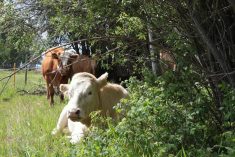There is a multitude of diseases to consider vaccinating for, and vaccines for them come in a multitude of combinations with different types of administration (subcutaneous or intramuscular) as well as different dosage amounts (usually two to five cc). These possibilities should all be considered when choosing vaccines.
First and foremost, use the advice of your local veterinarian. He/she will have chosen the most appropriate vaccines for your area in the best combinations available to minimize the number of needles to be given. Veterinarians are a valuable resource when it comes to vaccine selection a very critical point of biosecurity for your farm.
Read Also

Mosquito-borne virus could be devastating to sheep breeding operations
Cache Valley virus, a mosquito-borne disease that infects small ruminants, could be a devastating hit to small operations.
Vaccine companies are producing more and more vaccines in multiple combinations. This is because there are now several diseases routinely vaccinated for on most farms. Fewer choices are less confusing to producers, fewer needles are necessary and the cost per disease treated actually comes down.
In deciding the efficacy of vaccines among reputable pharmaceutical companies we are often splitting hairs. Veterinarians choose which vaccine lines to carry based on several factors including effectiveness, route of administration, dosage amount and dose sizing per container. Availability, price, timing of administration and service given by the sales force are also considered.
We are really almost comparing apples to apples when comparing the numerous vaccines available from the reputable companies. Again, your veterinarian will know which products compare favourably to one another.
There are a few misconceptions about repeating vaccine protocol. Different vaccine lines will generally boost the immune response from a previous vaccination from a different line of vaccines. Of course the diseases in the vaccines must be the same. The important thing to remember, whether it be from previous vaccination or exposure to the real disease, is that revaccination stimulates the body’s immune system to develop further protection from sickness.
Increased risk in some areas
Certain areas in Canada have a higher incidence of specific diseases and vaccination may be considered. An example of this would be Clostridium Hemolyticum in west-central Alberta. Horses are vaccinated for rabies in certain regions of Eastern Canada. Vaccination may be repeated in herds with a prior history of leptospirosis, and in outbreaks of anthrax the contact herd as well as neighbouring herds may be vaccinated in subsequent years. Anthrax is a reportable disease so the federal vets will vaccinate the contact herd initially.
Even though there are vaccines for other reportable diseases such as foot-and-mouth disease or brucellosis, they are not allowed to be used in Canada because we are free of these diseases and want to keep them out. If we were to vaccinate, the protection the vaccine affords could mask symptoms and carrier animals might develop. Tests for disease exposure often cannot differentiate between exposure to the real disease or vaccination, therefore eradication is difficult.
In most herds across Western Canada vaccination is now common for the diseases of IBR, BVD, PI3, clostridials (blackleg group 7- or 8-way or now 9-way), histophilus) the former hemophilus and BRSV. For young calves up to and past weaning the two respiratory pathogens pasteurella and mannheimia are becoming common. If we are careful how we mix and match these antigens, calves can get immunized with all these antigens in two needles.
Scours vaccination is becoming common for the breeding animals, especially in larger herds. A multitude of other vaccines for foot rot — especially in breeding bulls, pink eye and leptospirosis are more commonly used. Other vaccines for mastitis (in dairies), and as already mentioned anthrax are used in special occasions and would be done in direct consultation with your veterinarian.
Timing critical
The appropriate timing is critical in order to get maximum benefit from your investment in the vaccination process. A perfect example of this would be the current scour vaccines. Each company has a different concept as to how challenge occurs. As a result in order to achieve maximum benefit, the timing of vaccination before calving is critical and varies considerably between the different products. Some can be given as short as two weeks before calving where others must be about two to three months before calving in order to achieve optimal results.
It is extremely important to know which vaccine will fit best with your management and processing schedule. Also storage of vaccines (almost all need to be refrigerated) and handling when administered are critical to getting the maximum effect. Freezing or overheating of the vaccine before administration cannot be tolerated.
There are no magic bullets of vaccination replacing good management. Proper nutrition, parasite control and sanitation go a long way to preventing disease. All this augmented with a properly thought-out and implemented vaccination program will severely reduce the incidence of those diseases on your farm. Talk to your veterinarian as new products and ways of administration are coming out all the time.















